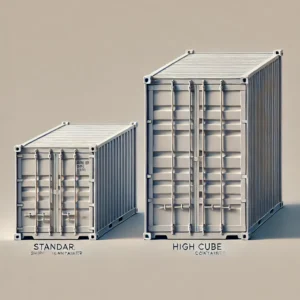What Are Standard Shipping Container Sizes?
Shipping containers play a crucial role in global trade and logistics. Whether you are in the shipping, construction, or storage industry, understanding standard container sizes is essential. The right container can make a difference in your efficiency, costs, and ability to transport or store goods securely. In this blog post, we’ll explore the most common shipping container dimensions, different grades available, additional container types, and who can benefit from them.

Standard Shipping Container Sizes
Shipping containers come in a variety of sizes, but the most common standard dimensions are:
20-foot container
- Exterior Dimensions: 20′ L x 8′ W x 8’6″ H
- Interior Dimensions: 19’4″ L x 7’9″ W x 7’10” H
- Door Opening: 7’8″ W x 7’5″ H
- Payload Capacity: ~62,000 lbs
- Volume: ~1,170 cubic feet
- Typical Use: Ideal for smaller shipments, personal storage, and small business inventory.
- Best For: Individuals and businesses needing a compact, yet spacious storage or shipping solution.
40-foot container
- Exterior Dimensions: 40′ L x 8′ W x 8’6″ H
- Interior Dimensions: 39’5″ L x 7’9″ W x 7’10” H
- Door Opening: 7’8″ W x 7’5″ H
- Payload Capacity: ~62,000 lbs
- Volume: ~2,390 cubic feet
- Typical Use: Used for larger shipments, industrial materials, and oversized goods.
- Best For: Businesses handling bulk goods and industries requiring spacious storage or transport options.
40-foot High Cube (HC) container
- Exterior Dimensions: 40′ L x 8′ W x 9’6″ H
- Interior Dimensions: 39’5″ L x 7’9″ W x 8’10” H
- Door Opening: 7’8″ W x 8’5″ H
- Payload Capacity: ~62,000 lbs
- Volume: ~2,690 cubic feet
- Typical Use: Ideal for taller cargo, additional storage space, and modified container projects.
- Best For: Businesses transporting taller cargo or those needing extra height for modifications.
45-foot High Cube (HC) container
- Exterior Dimensions: 45′ L x 8′ W x 9’6″ H
- Interior Dimensions: 44’5″ L x 7’9″ W x 8’10” H
- Door Opening: 7’8″ W x 8’5″ H
- Payload Capacity: ~62,000 lbs
- Volume: ~3,040 cubic feet
- Typical Use: Perfect for extra-long shipments and large-scale storage solutions.
- Best For: Large-scale transportation and storage projects that require additional space.
We carry 20ft, 40ft and 40ft high cube shipping containers! GET QUOTE!
Additional Container Types
- Reefer (Refrigerated) Containers – Designed for transporting perishable goods at controlled temperatures.
- Open-Top Containers – Feature a removable top for oversized cargo that doesn’t fit through standard doors.
- Flat Rack Containers – Used for large, heavy, or irregularly shaped cargo that needs loading from the sides or top.
- Tank Containers – Designed for transporting liquids such as chemicals, oils, or food-grade liquids.
Shipping Container Grades We Offer
Choosing the right grade for your shipping container depends on your intended use. Here are the grades we offer:
- New / One-Trip Containers – These containers have only been used once to transport goods and are in excellent condition. They are ideal for businesses or individuals looking for a long-term investment.
- Cargo-Worthy Containers – These containers meet international shipping standards and are structurally sound for transport. They are commonly used for overseas shipping or repurposed as storage units.
- Used WWT (Wind & Water Tight) Containers – While these containers are no longer suitable for international shipping, they still offer solid protection against the elements, making them great for storage, workshops, or conversions.
Who Can Benefit from These Containers?
Our shipping containers are suitable for a wide range of industries and applications:
- Logistics & Shipping Companies – Need reliable and secure containers for international and domestic transport.
- Construction Firms – Use containers for mobile offices, secure tool storage, or modular building projects.
- Retail & E-commerce Businesses – Perfect for inventory storage or pop-up shops.
- Homeowners & DIY Enthusiasts – Ideal for backyard storage, tiny homes, or creative workspace solutions.
- Agriculture & Farming – Store equipment, feed, or use them for hydroponic farming setups.
- Oil & Gas Industry – Utilize containers for equipment storage and secure on-site offices.
Delivery Options
We ensure smooth and efficient delivery of your shipping containers using:
- Tilt-Bed Trailers – Ideal for quick and easy unloading, allowing the container to be gently placed onto the ground without the need for additional equipment. Read more about tilt-bed delivery requirements here.
For a successful delivery, make sure your site is properly prepared. Check out our Site Preparation Guide to ensure safe unloading and placement of your container.
Factors to Consider When Choosing a Shipping Container Size
Now that you know about the three best-selling shipping container sizes, how do you decide which one suits your needs? Several factors should influence your decision:
Cargo Volume and Weight
Consider the size and weight of the goods you’re shipping. A 20-foot container might be perfect for smaller items, but if you’re dealing with bulkier or heavier cargo, a 40-foot container could be more practical. High cube containers are the choice for exceptionally tall or oddly-shaped items.
Shipping Costs
Shipping costs are often tied to the size of the container. Smaller containers generally cost less to ship, but if you need to transport a large volume of goods, a larger container can be more cost-effective in the long run. It’s essential to balance upfront expenses with overall shipping expenses.
Available Space
Do you have enough space to accommodate the chosen container at your location? Consider the dimensions of the container itself, as well as the clearance space needed for loading and unloading. It’s no use having a perfect container if it won’t fit where you need it.
Customization Needs
Some businesses require modifications to their containers, such as adding ventilation, doors, or windows. Smaller containers may be easier and more cost-effective to customize, while high cube containers offer more room for creative adjustments.
Accessibility and Location
Think about the accessibility of your chosen location. Are there height restrictions, narrow streets, or limited access points? High cube containers, with their extra height, may not be suitable for all delivery locations.
Conclusion
Understanding standard shipping container sizes, delivery methods, and grades can help you make an informed decision for your business or personal needs. Whether you’re looking for a durable storage solution or a container for international shipping, selecting the right size and grade is key. Knowing the various modifications available can also help tailor the container to your specific requirements.
Looking for high-quality shipping containers? Contact us today to find the best container for your needs!
FAQ
What is the difference between a standard and high cube container?
A high cube container is 1 foot taller than a standard container, providing extra storage capacity.
Can I use a cargo-worthy container for storage?
Yes, cargo-worthy containers are great for storage, but they are also structurally sound for international shipping.
How long do shipping containers last?
With proper maintenance, a used container can last 10-15 years, while a new one can last 25 years or more.
Do you offer modifications on containers?
Yes! We provide customization options such as doors, windows, and vents.
Internal Links to Explore Further
- How Much Weight Can a Shipping Container Hold?
- Difference Between 20ft and 40ft Shipping Containers: Which One Is Right for You?
- High Cube vs Standard Shipping Container: Which One Fits Your Needs Best?
- What Is an Insulated Shipping Container? (And How It Differs from Refrigerated Containers)
- Shipping Container Door Options: What Are the Best Alternatives to Side-Door Containers?
- Best Materials for Shipping Container Walls – A Comprehensive Guide for Your Container Conversion Project
- 20ft shipping container: A full guide
- 40ft Standard Container: A full guide
- Shipping Container Flooring Options: Best Materials for Durability and Safety
- Shipping Container Ventilation Requirements – A Comprehensive Guide for the US Market
Get quote!

No strings attached 💯